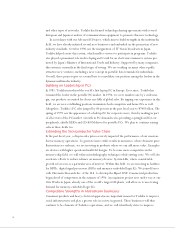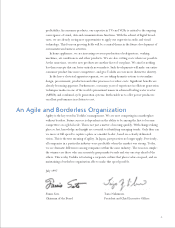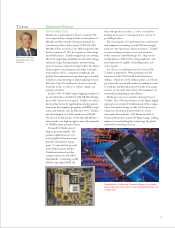Toshiba 1997 Annual Report Download - page 16
Download and view the complete annual report
Please find page 16 of the 1997 Toshiba annual report below. You can navigate through the pages in the report by either clicking on the pages listed below, or by using the keyword search tool below to find specific information within the annual report.
14.
Heavy Electrical Apparatus has long been a relatively stable source
of sales and earnings for Toshiba. But now we are seeing a drop in
capital spending by electric utilities in Japan as calls rise for rates to
fall to levels comparable with those of other industrialized nations.
What are Toshiba’s plans for coping with this challenging
environment?
Price competition in the power generation and distribution field is much
more intense than before. Capital spending at electric utilities is shrinking, and
the utilities’ procurement activities are becoming more diverse. Even mainte-
nance costs are targeted for reductions. Overall, this creates an extremely diffi-
cult situation, particularly with regard to pricing. Another challenge is the
decline in construction of nuclear power stations. We regard thermal power
stations as the chief source of sales for the time being. By 2000, our goal is to
raise sales of these power stations by 50 percent to about ¥300 billion. This will
A
Q
potential benefits of a centralized management system are enormous. This management system is now being
applied to our nuclear power operations, and will become part of other business activities in time.
Asia represents one of the world’s largest markets for power generation and distribution
systems. How is Toshiba capturing business here in the face of intense competition from
companies in Europe and the United States?
With orders slowing in Japan, we are relying more and more on overseas markets, especially Asia, to
support growth in our power systems businesses. We expect that demand for electricity will continue to rise
in these markets for quite some time. Naturally, manufacturers from around the world, as well as those
within Asia, are all competing fiercely to capture as much of this business as they can. Presently, most orders
for power systems are for thermal power stations owned and operated by independent power producers. In
the near future, though, we expect to see growth in demand for nuclear power facilities.
In January 1997, Toshiba and Hitachi formed the Asia ABWR Promotion Organization. This gives us an
effective vehicle for capturing orders for nuclear power stations in China and elsewhere in Asia. Toshiba has
already been awarded a contract for the construction of an ABWR facility in Taiwan, along with Hitachi and
General Electric of the U.S. The new organization will make technical presentations, conduct feasibility studies,
and gather and analyze technical information in other nations. Through these activities, we plan to raise
awareness of ABWR technology, and Toshiba’s own expertise. We project that overseas clients will account
for about 30 percent of our thermal power activities by fiscal 2000, well above the present 10 percent.
Heavy Electrical Apparatus Strategic Overview
Q
A
14.
give us a domestic market share of roughly 30 percent. Demand for power generation is exhibiting strong growth in several overseas
markets. There are many opportunities for us to capture orders for thermal power stations and equipment for substations. By seizing
these opportunities, we plan to raise overseas business from 10 percent to 20 percent of sales. We believe that these actions will allow us
to continue generating a healthy level of sales in this segment.
What is the status of your ongoing efforts to cut costs?
We have much expertise in extremely efficient power generation systems that offer outstanding performance relative to their costs.
ABWR and combined-cycle systems are the two primary examples. The ABWR design produces about 20 percent more power than a
comparable BWR facility, yet is 15 percent less costly to build per kilowatt of output. However, we are seeking even more ways to cut
costs. This is why Toshiba is working on the adoption of more uniform designs and the expansion of procurement of materials from
overseas suppliers.
We are also upgrading our database of power station projects. Our aim is to apply a product data management system to these
projects so that we can centralize the supervision of everything from planning and production through maintenance of the completed
facility. A single nuclear power unit requires about 2,000 designers and more than 10 million pages of documents. Obviously, the
A
Q
Nuclear power
Thermal power
Hydroelectric power
30% 34% 20% 8% 8%
40% 25% 24% 11%
34% 33% 18% 15%
TOSHIBA
Company A
Company B
Company C
Company D
Others
Note: Turbine-generated power
as of March 1995
Power Generation Capacity in Japan
90 95 2000* 2005*March
100
150
200
60
80
100
(GW) (GWh)
Electricity Sales &
Peak Demand
Peak demand
Electricity sales
* Estimate
























